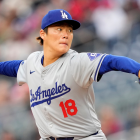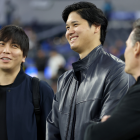Later this month, Opening Day will blessedly descend upon us, and that means the time is nigh for thinking about baseball matters beyond banging schemes and free agents. To get you into that most righteous headspace to focus on the results of actual games and what they mean for actual playoff races, we're here to lay out each division's X-factor that will go a long way in determining who wins said division. Such matters are never reducible to one single thing, but what follows may wind up being the most important consideration.
Did you skip the intro above? Good. Now let's take a look at the leading X-factor for each of MLB's divisions.
AL East: The Yankees' health
On the one hand, the Yankees barged to 103 wins and the AL East title in 2019 despite an absurd run of injuries. They'd prefer not to have to do that again, especially in Gerrit Cole's first year in pinstripes. Early indicators, however, suggest that Aaron Boone and his charges may be tasked with digging deep into the roster once more to turn up wins. We're not even knee deep into Cactus and Grapefruit League play, and already the Yankees have lost No. 2 starter Luis Severino to Tommy John surgery and James Paxton to back surgery (he could be out until June) and learned that outfielders Aaron Judge and Giancarlo Stanton likely won't be ready for Opening Day. As well, fellow outfielder Aaron Hicks is likely out until mid-season after undergoing a Tommy John surgery of his own.
In a sense, none of this is surprising. Yes, the Yankees turned over much of their training and medical staff after the debacle of 2019, but nothing predicts injuries in a given season as strongly as injuries in the prior season. Those are the headwinds for the Yankees in 2020. Yes, the roster remains deep, and to repeat they thrived in 2019 despite getting very little from Severino and Stanton. That said, they're also older in some key spots, and do they want to bank on big repeat years from, say, Gio Urshela or Brett Gardner in his age-36 campaign? Along those lines, J.A. Happ has gone from unnecessary salary sinkhole to rotation linchpin.
If there's good news for the Yankees, it's that the Red Sox aren't trying hard to compete, and while the Blue Jays are improved they don't figure to seriously contend. One can also argue that the Rays, while still likely to contend, worsened themselves with their offseason roster churn. If the Yankees get even more banged up, the Rays, however, could be threats to overtake them.
NL East: The Nationals' Rendon replacement
While the world champion Nats were able to re-up with Stephen Strasburg, they took a major body blow when franchise third baseman Anthony Rendon signed with the Angels. That leaves a big void at third base and in the No. 3 hole in the lineup. The Nats also failed to land Josh Donaldson -- the top Rendon proxy on the market -- or swing a trade for Kris Bryant or Nolan Arenado (not that such a blockbuster was entirely up to GM Mike Rizzo). That means they'll try to replace Rendon's 6.3 WAR from a season ago with internal solutions.
Howie Kendrick and Asdrubal Cabrera are back in D.C., but the hope is that top prospect Carter Kieboom is ready to seize the job and realize his high ceiling. Kieboom, 22, is a former first-rounder who's slashed an impressive .287/.378/.469 across parts of four minor-league seasons while spending most of his time at shortstop. He's been a regular on top 100 prospects lists in recent years, and coming into 2020 Kieboom was ranked the No. 11 overall prospect by Baseball Prospectus, No. 15 by Baseball America, and No. 21 by MLB.com. Our own R.J. Anderson ranked him No. 18 and wrote that Kieboom "profiles as a potential regular thanks to his bat and strong throwing arm, both of which grade as at least above-average, if not better."
Kieboom struggled badly across an 11-game cup of coffee early in the 2019 season, but the sample was tiny. Back in Triple-A he resumed producing at a solid level (although perhaps not as impressive as it seems at first blush, thanks to the absurd run-scoring environment in the PCL last year). The question for the Nats is whether Kieboom can win the third base job coming out of camp and provide a soft landing from the level of production Rendon provided in 2019. There's no plausible way to think Kieboom will put up Rendon numbers, but Washington needs him to put up above average outputs at the plate by positional standards. Kieboom will eventually be that sort of player, but whether he can be that sort of player on a short learning curve in 2020 is the key.
AL Central: The Twins' power
The Twins last season topped 100 wins for just the second time in franchise history. That was largely because of Minnesota's legendary power up and down the lineup (and an assist from the mostly terrible remainder of the AL Central). Eight players tallied 20 or more homers, and 11 Twins reached double figures in home runs. In matters related, the Twins set an all-time record with 307 home runs as a team. This offseason, they've added slugger Josh Donaldson to the fold, so they once again figure to be driven by power.
Speaking of driven by power, the Twins last season scored more than half of their runs by virtue of the home run, and among AL teams only the Blue Jays were more reliant on over-the-fence power. Along the way, Nelson Cruz continued to defy the aging curve, and a number of other players enjoyed career years. So what if age and regression visit the Twins in 2020? And what if the actual baseball is less conducive to power production?
In the AL Central, the Indians still profile as contenders (so long as they don't stupidly trade Francisco Lindor), and the White Sox have added very useful veteran pieces to their impressive core of young talent. If the Twins' power fades significantly in 2020, then the Central could be in play.
NL Central: The Cubs' rotation
The Cubs last season finished in third place, missed the postseason, and posted their worst record since 2014. That said, the race in the NL Central was tight, and the Cubs posted the strongest run differential. It figures to be another hotly contested race in 2020, especially with the Reds making substantial winter improvements, but one can easily argue that the Cubs have the strongest roster on paper. Ultimately, the division may be decided by how the Chicago rotation fares.
Last season, the Cubs ranked a strong third in the NL in rotation ERA but a somewhat less impressive sixth in FIP. That latter ranking could foreshadow a bit of decline in 2020. Cole Hamels departed via free agency, and every starter in the projected rotation is older than 30. Jon Lester "leads" at age 36. Also, Lester and Kyle Hendricks spent time on the IL last season, and that's to say nothing of Yu Darvish's substantial injury history. There's also not a great deal of depth. Right now, Tyler Chatwood is penciled in as the fifth starter. Should injuries or ineffectiveness strike, then the Cubs may be forced to turn to less certain options like Jharel Cotton, Colin Rea, Adbert Alzolay, or Tyson Miller. There's some depth in terms of numbers, but there's possibly not depth in terms of quality innings. That could be a worry for a Cubs rotation that's a bit long in the tooth. It's also left to question whether Cubs ownership, which refused to spend this winter, would approve any sort of curative deadline addition that involved taking on salary.
Again, the Cubs -- thanks in part to the fact that they didn't trade Kris Bryant or Willson Contreras, contrary to some rumors -- probably have the strongest on-paper roster in the division. It's going to be a competitive loop, however, and there's collapse potential in the Chicago rotation. Whether that collapse comes to pass or is avoided could be determinative.
AL West: The Astros' starting pitching
Despite the sign-stealing scandal and the doubts cast upon their 2017 belt and title, the Astros are going to be a very good team in 2020 and have legitimate designs on returning to the World Series. Even though they'll be heavy favorites in the AL West, the rotation could be a soft underbelly.
As noted above, Cole is now a Yankee, and that's a huge loss. Justin Verlander and Zack Greinke return, but they're a combined 73 years of age and have pitched more than 6,000 regular season innings combined. They both project well for 2020, but at that age sudden and sharp decline is possible for either. Likely rounding out the Houston rotation will be Lance McCullers Jr., Jose Urquidy, and Josh James. McCullers missed all of last season due to injury, and he's yet to reach 130 innings in a season. Given his history at the highest level, a full season of health for McCullers would be a surprise. Urquidy, Houston's breakout star last October, set a new career-high by tossing 144 innings between the majors and minors in 2019, and James pitched to a 4.70 ERA out of the bullpen in 2019. Brad Peacock could provide some depth, but that would be at a cost to the bullpen, which already lost Will Smith.
If injuries or age-related ineffectiveness hit the Houston rotation in 2020, then that could be an opening for the Athletics or even the revamped Angels.
NL West: The Dodgers' worst-case scenario
The Dodgers won 106 games a season ago, and if you look at their runs scored and runs allowed they played more like a 107-win team. Add Mookie Betts and a full season of Gavin Lux to a mostly intact team that claimed the NL West by 21 whopping games last year, and it would take a most unlikely sequence of events for the Dodgers not to win their eighth straight division title.
Speaking of which, if you look at the projected standings churned by the PECOTA system at Baseball Prospectus, you'll see that -- in broad terms -- the Diamondbacks and Padres catch the Dodgers only if their best-case scenario scenarios line up with the Dodgers' worst case scenario. That's highly, highly unlikely to happen.
The Dodgers have added Betts to perhaps the best offense in baseball, the bench is loaded, and they have more viable major league starting pitchers than they can use. Really, they have little chance of winning fewer than 95 games, and the D-Backs and Pads, in turn, have little chance of reaching 95 wins. For the Dodgers to hold up their end of that scenario, they'd need a Yankees-grade run of injuries in tandem with significant age-related decline from the roster's elder statesmen like Clayton Kershaw, Justin Turner, and David Price. Even if all that happened, though, the Dodgers would still likely prevail.
So what's the X-factor here? Nothing more than the faint possibility of a genuine baseball miracle, which is what it would take for a team other than the Dodgers to win the division in 2020.






















